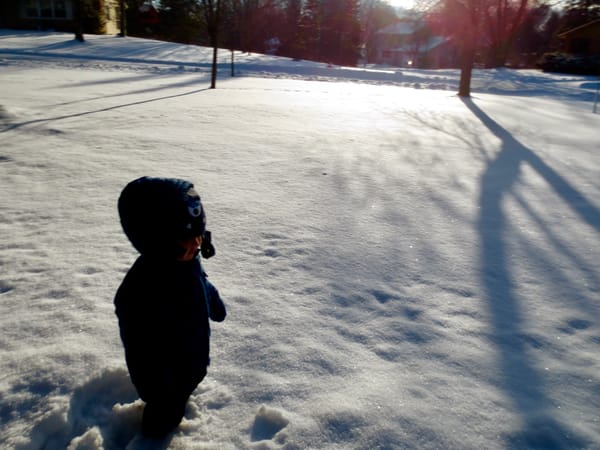Why I Always Begin with Poetry
A love letter to Andrea Gibson, sunbeams, and open-hearted storytellers

“Even when the truth
isn’t hopeful,
the telling of it is.”
~Andrea Gibson
As a teacher, it’s my job to understand how different people learn, which I think about less in the dubious sense of learning styles, and instead in a more nuanced way that has as much to do with temperament, individual interests, and personal connection as with the internalization of information. Teaching is primarily the work of accessing minds and luring students into, not just tolerating, but actively pursuing difficulty. We learn when we are stretched beyond our capacities. This doesn't mean learning isn't often pleasurable, but it does necessitate a tolerance for the uncomfortable feeling of being on the edge of an understanding or a skill that you can’t quite grasp yet. It’s a teacher's job to make this experience of grappling and stumbling enticing, not with tricks and rewards, but by understanding what sparks the kind of deep curiosity that motivates a willingness to enter the unknown and to persist through challenges.
As a writer, though, in addition to accessing minds, I think a lot about accessing something more ephemeral, because, where it’s a teacher's job to disrupt patterns of thought, deepen understanding, and unlock new ideas and skills, it’s a writer’s job to alter the filters through which we see and understand each other, to find meaning in joy and beauty as well as in the incomprehensible and unacceptable. This involves tapping into a well of longing and common experience. And, just as there's individual variation to the topics and tasks that entice us to stretch our minds, there is individual variation to the access points for our hearts. If you’ve been reading Notes on Hope for a while, you know that I always begin with poetry, and this is why.
Poetry is often taught as if it’s a foreign language to be dissected and analyzed in order to build fluency, rather than as a distillation of language that is meant to drill directly into the core of our most human experiences. But the structure of poetry isn’t meant to be an algorithm we tackle and solve. The structure isn’t the meaning or the prize. The structure of a poem is the bones and the heartbeat. It gives life to the words and connects them to our own pulse, often invisibly, so we can hold the language and feel the experiences a poem describes mapped onto our own interior world. I begin with poems because they can often reach our hearts more readily than any other form.
“It is a vital necessity of our existence. It forms the quality of the light within which we predicate our hopes and dreams toward survival and change, first made into language, then into idea, then into more tangible action. Poetry is the way we help give name to the nameless so it can be thought. The farthest external horizons of our hopes and fears are cobbled by our poems, carved from the rock experiences of our daily lives.”

I’m thinking about poetry even more than usual this week, because Andrea Gibson, a poet who had a deep understanding and reverence for the life-giving power of language, died last Monday. Their death created a rupture that felt uncommon, even within a celebrity-infused internet culture, where it’s oddly easy to feel personally tethered to those we’ve never actually met. The flow of grief online and in the media felt unusual and specific. Sometimes the tendency to mourn celebrity passings as personal losses can feel strange and almost cultish, as we worship stars we don't really know. But there was something raw and real in Gibson’s loss that seemed, instead, entirely aligned with the raw nature of their life and work. It felt right and necessary.
An unexpected sense of connection also emerged, as the true scope of the ripple of Gibson’s impact became clear. There was an intimacy to their poetry that belied the reach of their fame, and this is what made both Gibson’s work and their death so personal and so powerful. Tracey Anne Duncan wrote,
“I didn’t even know Gibson was truly famous until their death. Since I didn’t learn about them in school, my relationship with their work felt intimate and singular. It turns out everyone felt that way. I think that’s what it actually means to be a poet’s poet—everyone everywhere gasping, ‘Me too,’ like widows meeting our sister wives.”
I’ve been a poetry person for a long time. But I learned about Andrea Gibson from a friend who is decidedly not a poetry person and who usually finds meaning more easily by engaging with the world physically, rather than through the written word. But Gibson’s words always lived most actively in performance. They were a spoken word poet first and foremost, and their performances facilitated emotional resonance more widely and equitably than the reach of words that reside exclusively on the page.
I have a vivid memory of the night my friend first sent me a link to one of Gibson’s most widely circulated poems, "Your Life." It was late. We’d walked around Brooklyn together for hours, stopping occasionally for something to eat or for a drink, but mostly walking. We were both grappling with hard things, and some conversations only happen when you’re moving, at least in New York. I was on my way back to the subway sometime after midnight, and the evening’s conversations were still swirling in my mind when my phone buzzed with a message from her that said, “This saved my life,” followed by a link. I stopped where I was and listened, as my phone glowed in the dark New York night, to a poem that once saved someone I loved.
If it’s true that saving a single life saves the entire world, I’m certain that Andrea Gibson saved the world many times over. Their work reached through the page and the screen to assure the most vulnerable that the very things that make us feel most isolated are often, in fact, the most common and connective, or in their words,
“that we are truly not alone in this,
that our veins are absolutely strings
tied to other people’s kites,
that our lives are that connected.
That my butterflies are never gone,
they’re just flying around
in someone else’s belly sometimes.”
Gibson walked the tightrope that the best poets walk. They found words that felt as though they were waiting to be etched out of the unspeakable, to give voice to experiences we’d thought we held alone. The potential for language to cut through isolation in this way is what makes a poem, as Joseph Fasano says, “a moral organism.”
Andrea Gibson held this responsibility with both sacred reverence and utter vulnerability. And in this tender balance, they saved lives with words that were made only more powerful by being spoken aloud. The tremble in Gibson’s throat—which was evidence of both the urgency of their words and of their own near paralyzing stage fright—always seemed to testify to the tremble in our own throats as we listened, felt their vulnerability and their courage, and became more able to accept our own vulnerability and locate our own courage. Because, somehow, in sharing their deepest fears and sorrows, there was always a generosity that offered hope and an opening for joy, even if it was just a tiny pinprick. They created a web of connection between beauty and suffering, and between the perception of individual experiences, that served as an offering and a beacon. As Fasano explains,
“The line between sentimentality and life-saving clarity is razor-thin, and the poet must risk it…our task as poets is to say what’s common, extraordinarily.”
This was never more evident than in Gibson’s experience with cancer over the past few years, as they mined mortality for the sweetest marrow of life, reminded us that pain and bliss are both evidence that we're still alive, and, most importantly, tried to convey the deep compassion that comes from feeling profoundly connected to everything else that lives. They instructed us,
“Rubble the walls between yourself and everyone until you’re sure the scenes of strangers’ lives will pass before your eyes when you die. If that doesn’t make sense right now, it will one morning, when you wake at sunrise, walk out to your porch, and see a flock of ten thousand starlings circling above your head. There I am, you’ll think, looking up at us. There I am.”
The thread that wove fragility, strength, sorrow, and compassion together in Gibson’s work is, I think, the reason their death has felt deeply personal to so many, who only knew them through their words and voice. They had a way of making the reader or listener feel known and held in shared experience and of eliciting courage and care, even from the deepest pain or the simplest pleasure. This sensation was so strong it could literally save lives, and their loss feels like that life-saving net has become finer and more translucent.
But Gibson’s most vital lesson was that the net is, in fact, always there. Their words didn't create the threads that connect us all, they revealed them. And, like dew drops on a spider web, the threads remain even as the dew melts in the sunlight. In their absence, we must work to remember this and continue to make the threads visible and tangible. In an interview last year, Gibson said,
“I think that the artist’s primary job is to tell the truth. But I think there is an additional job, which is to create hope, to inspire awe. I think the poet’s job is to remind us that we were born astonished. I have since learned that we are never ever supposed to grow out of that.”
The power of poetry is also that it lives on and continues to ripple out into the world far beyond the poet. The sense of recognition and hope that Andrea Gibson’s words nourished will continue to ripple out from their pages and performances and find new lives to cradle. Our task now is to ensure that their words not only hold us but make us more compassionate and more committed to holding one another—to lift cities with our hearts, as they promised we could.
“A difficult life is not less
worth living than a gentle one.
Joy is simply easier to carry
than sorrow. And your heart
could lift a city from how long
you’ve spent holding what’s been
nearly impossible to hold.
This world needs those
who know how to do that.
Those who could find a tunnel
that has no light at the end of it,
and hold it up like a telescope
to know the darkness
also contains truths that could
bring the light to its knees.
Grief astronomer, adjust the lens,
look close, tell us what you see.”
Let’s all strive to live as fiercely, honestly, and generously as Andrea Gibson did—to tell our stories and receive the stories of others with gentleness, and to recognize the power in doing so.
Goodnight, sweet poet. Thank you for saving my friend and so many others. You deserve flights of angels.
Wishing you the courage to tell your story, the safety of hearing it echoed in the stories of others, and the compassion to hold tenaciously to the threads that connect us,
Alicia
P.S. In acknowledgement of the power of personal story telling to change our hearts, humanize strangers, and shift our actions, this week's "helpful and hopeful" links, below, are all personal narratives. I hope you'll spend some time opening your heart to these stories.
A few things I found helpful and hopeful this week…
- Rumeysa Ozturk's essay on her experience being held in ICE detention, Even God Cannot Hear Us Here
- A personal account of one family's experience of the Texas floods, The River House Broke. We Rushed in the River.
- The story of a group of men in a maximum security prison, who volunteer, making quilts for foster children, The Quilters
- Explore the stories of teens, told through spoken word poetry, at Get Lit, Words Ignite
- And, finally, because Andrea Gibson delighted in nature and connected strongly with the vulnerability of animals, a story about sandhill cranes adopting a baby goose






